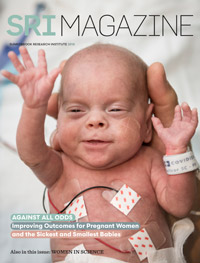Women in science: a lab of their own

Successful female scientists reflect on their journeys and offer counsel to the next generation looking to them and wondering: Is it possible to have it all?
September 12, 2018
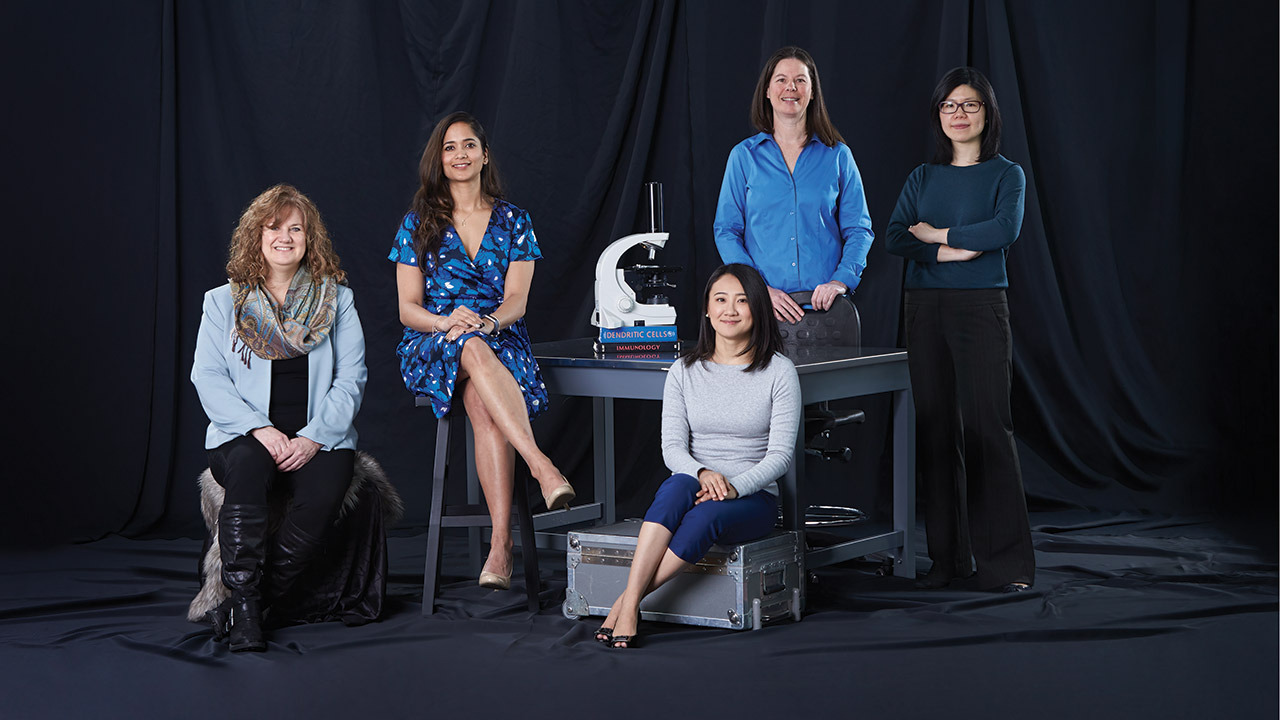
From left to right: Dr. Michele Anderson, Sonam Dubey, Miho Tanaka, Dr. Isabelle Aubert and Dr. Joyce Chen.
“I was taught that the way of progress is neither swift nor easy.”
—Marie Curie, Nobel laureate in physics
Dr. Michele Anderson has fond childhood memories of being in a lab, watching as her father, a physiologist at Johns Hopkins University, did experiments to understand the causes of high blood pressure. As a student, she excelled in science; the more she did, the more her passion for it grew.
Her love of research notwithstanding, Anderson didn’t think that she would one day run her own lab. During her PhD, Anderson, who is now a senior scientist in Biological Sciences at Sunnybrook Research Institute (SRI), thought she would become “someone who worked in the lab over a longer term, but not the person who wrote the grants and travelled,” she says. “I was brought up to think that that’s not what women do. I was told if I wanted a family, I couldn’t do both.”
Anderson, who is a mother to two sons, persevered. Also an associate professor in the department of immunology at the University of Toronto, she creates and studies mouse models to understand how T cells develop. She is working on a way to manufacture T cells from stem cells derived from human skin cells. She recently was awarded a grant from the Canadian Institutes of Health Research (CIHR) at a time when average funding rates hover at about 16%, and she has published two papers within the last year in the highly regarded journals Nature Communications and Stem Cell Reports. She’s staying put.
Other women with PhDs in science, however, are dropping out of the field—a phenomenon known as “the leaky pipeline.” Census data on university academic staff published in 2018 by Statistics Canada show that although the numbers of men and women who obtain PhDs in the health sciences are comparable, the representation of women drops off with each step up the faculty ladder. Among health researchers at the assistant professor level, there are 1.24 times more males than females; at the level of full professor, men outnumber women by 3.55. These numbers are reflected at U of T, where the proportion of full-time, tenure or tenure-track women holding the rank of assistant or associate professor is close to parity, at 43% and 42%, respectively; however, women account for 27% of all full professors.
Why are women leaving science? One still-resonant reason, and one not exclusive to science, is the challenge that comes with juggling work and children. A 2018 survey on work-life balance by Times Higher Education reveals that 43% of female academics with children say that parental responsibilities hold back their careers “significantly” or “a great deal.” Moreover, among respondents who do not intend to have children, 63% of female academics attribute this decision in part to the fear that having kids would be irreconcilable with their career. Tellingly, nearly one-half of the respondents, who work in Europe, the U.S., Canada and Australia, were younger than 40 years of age, suggesting that concerns about balancing work and family are very much a contemporary issue.
This is not to say that men don’t feel pressure or experience issues balancing life in the lab with that at home, but research shows women in science disproportionately bear the burden of family responsibilities, making it harder for them to engage in career-building activities like attending conferences and networking events outside regular work hours. In 2017, the Equity Challenge Unit published a report on gender equality in science, technology, engineering and mathematics (STEM). The report, which surveyed close to 5,000 academics from the U.K., revealed that more female than male respondents had taken parental leave, or were caregivers for another adult. Statistics Canada data from 2015 show that women spend 50% more time than men doing unpaid household work, including chores and caring for children or adult family members. Reflecting on the early part of her career, Anderson says she can relate. “There weren’t a lot of faculty leaving to pick up their kids at 5 p.m. They would schedule a meeting for 5 or 6 p.m. and say that time was necessary for the clinicians to be there. I think the majority of men older than me had other people taking care of their kids, [whereas] the majority of women didn’t. That was very difficult because the people making the rules didn’t have the same constraints.”
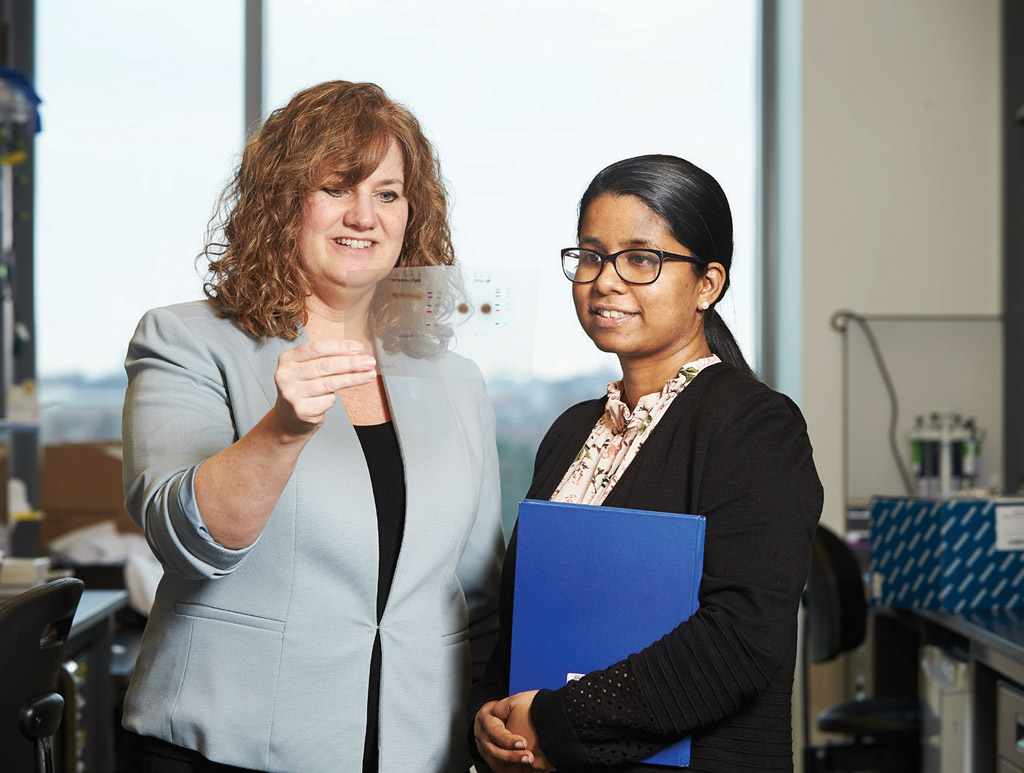
Dr. Michele Anderson (left) and Dr. Johanna Selvaratnam, a postdoctoral fellow in the lab. The Anderson lab is studying preclinical models to understand how T cells develop.
Dr. Joyce Chen, a scientist in the Hurvitz Brain Sciences Research Program at SRI, says the demands of her job influenced the decision to have one child. “I’d be lying if I said that [work] didn’t factor in,” says Chen, who took a shorter maternity leave to return to work early. Her research is on rehabilitation after stroke. She is studying how to recover movements using noninvasive brain stimulation. The Heart and Stroke Foundation recently awarded her a grant to develop a personalized approach to motor recovery using transcranial direct current stimulation.
Chen’s decision is not an uncommon one. In a 2011 study published in PLOS One, Drs. Elaine Ecklund and Anne Lincoln showed that female scientists at universities in the U.S. have fewer children than do their male colleagues, and are more likely to say that they have fewer children than they want owing to their careers. “I would have liked to have had two [children], but it was the stress of being a woman in science and needing to get all these grants. There was never a good time, and time ticked away,” says Chen. “Now the [age] gap is too big. Being able to keep up at work and wanting to have a family is just not compatible, in a sense.”
She is careful to note that all scientists face the same pressure to get funding, and have to sacrifice some of their personal lives—whatever that looks like—to do their jobs. She says that it’s a trade-off she is happy to make. “For most academics, I am assuming based on my experiences, we enjoy work, and so, the line gets blurry between work and play. It is easy to get caught up in work. When I was a grad student, that wasn’t a problem because I was single. Now that I have a family, I need to achieve a balance,” she says. Chen, who is also an assistant professor in the faculty of kinesiology and physical education at U of T, credits having a supportive spouse with being able to juggle work and family, but even so, she says that trainees should have no illusions about what a future in academia is like. “This is the lifestyle that you will experience, and somehow you’re going to have to figure out how your life fits in. I’ve gone to panels about work-life balance in academia—by the way, which were dominated by females—but no one has the answer. It’s specific to each individual. You have to make peace with whatever balance you achieve,” she says.
Anderson also doesn’t pull any punches when describing the life of a scientist. She says that she encourages trainees to pursue this path, but warns that it will be hard. “There can’t be anything else you’d want to do, or even consider doing. Science has to be the love of your life.” She also says that she doesn’t regret her choices. “I’m very grateful to have this chance to do what I love for a living.”
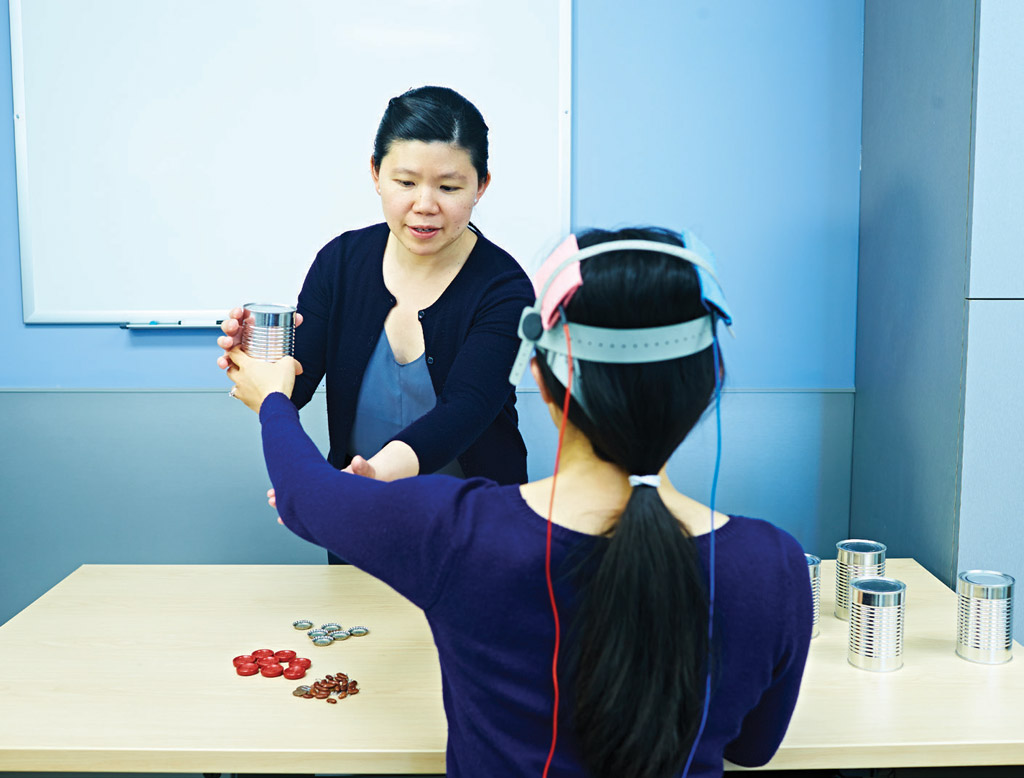
Dr. Joyce Chen is researching the use of noninvasive brain stimulation to help people recover movement after a stroke.
Universities have tried to address the issue of work-life balance with policies like “stopping the tenure clock,” which enables faculty to delay their tenure review due to family responsibilities. One limitation, however, is that those on evaluation committees don’t always understand how parental leaves affect productivity, a finding that is noted in a 2012 report published by the Council of Canadian Academies. To this point Chen says, “[Maternity leave] is taken into account, but not quantified, and I think it should be—for example, ‘if you’ve taken a mat leave, we expect two fewer papers from you.’ There’s no practical, objective measure of the effect of mat leave.”
Dr. Isabelle Aubert, a senior scientist in Biological Sciences at SRI and a professor in the department of laboratory medicine and pathobiology at U of T, also took shorter maternity leaves after the birth of each of her two daughters so as not to fall behind. “During my mat leave, I occasionally brought the kids to my office and worked from home, developing innovative ways to hold a baby and type. It was challenging, but I was happy to be able to work and be with my kids at the same time. The flexibility of an academic career definitely helped,” she says.
Like Chen, Aubert credits a highly involved partner. “When the kids are sick, my husband and I take turns to stay home with them,” says Aubert. “Being a scientist as well, he is able to adjust his schedule. The lifestyle of a scientist has many positive aspects. We can be with our kids when needed, and can even travel the world with them.” Anderson is equally positive about the benefits that come with the challenges. “It comes with wonderful activities like travel and meeting amazing people around the world. And having a family is also amazing, and something I wouldn’t want to have missed out on,” she says.
Also funded by CIHR, Aubert is developing therapies to stop neurodegeneration and promote regeneration in Alzheimer’s disease. She is evaluating the capacity of drugs, immunotherapy, and gene and cell therapies to maintain the health of neurons and induce brain repair. Her research using focused ultrasound to deliver therapies directly to the brain in preclinical models of Alzheimer’s disease has led to several world-first publications in this hot area. In addition to being a mother, Aubert is an avid skier and teaches martial arts. In the past, colleagues have told her that her life outside the lab would compromise the quality of her science. Initially, such comments undermined her confidence. “At the start of my career I didn’t talk about my karate, my skiing and my family because the feedback I was getting suggested that I was not a committed scientist when I was,” she says. She has since learned to shrug off dismissive remarks.
Women in science contend with subtle forms of discrimination arising from stereotypes about gender roles, as well as systemic inequities in hiring, promotion and compensation. According to 2016 Statistics Canada data, female academics on average make 90% of male scholars’ salaries when pay is broken down by hourly rate. A 2016 study by Dr. Catherine Buffington and colleagues published in the American Economic Review looked at the salaries of about 1,200 U.S. PhD graduates in STEM. Even within the same field, women made 11% less than men in first-year earnings, a gap based on the finding that married women with kids earned less than men. Neither married men with children nor unmarried women without kids were disadvantaged in pay.
In the realm of publishing, Dr. Luke Holman and colleagues published a study in 2018 in PLOS Biology that reported a gender gap across journals in science and medicine. They determined the numbers of men and women authors listed on more than 10 million academic papers and found that women are less often the last author or sole author—positions denoting seniority. For example, in 2016, the proportion of female last authors published in Nature and Science were 18.3% and 21.9%, respectively. The researchers made a worrisome prediction that in certain fields like physics, surgery and computer science, equal representation won’t be reached this century, given how slowly the rates of women authors are climbing.
Gender disparities also exist around colloquium talks, which not only enhance a researcher’s reputation, but can also lead to collaborations and job offers. A 2018 study by Dr. Christine Nittrouer and colleagues published in the Proceedings of the National Academy of Sciences analyzed thousands of talks across six disciplines. The researchers found that men gave more than twice as many talks than women overall. This gap could not be attributed to women declining invitations to give talks more frequently or valuing such opportunities less. On the flip side, 2014 research by Drs. Arturo Casadevall and Jo Handelsman published in mBio showed that women’s participation on organizing committees for scientific symposia is correlated with a much higher proportion of invited female speakers.
Women are also under-represented in the upper echelons of academia. In 2008, the federal government created the Canada Excellence Research Chairs Program to attract the world’s best researchers. Each university successful in securing a chair is awarded up to $10 million over seven years. In the inaugural competition, 19 chairs were awarded—all to men. The outcome prompted the minister of industry to form a committee to examine the selection process. It found that no universities had nominated a female candidate in the second phase of the competition. To this day, 25 of the 26 program chairholders are men; Dr. Luda Diatchenko, of McGill University, became the first female chairholder in September 2013. (Another was awarded to Dr. Jennifer Hoffman, then at the University of British Columbia, but she returned to the U.S. soon thereafter.) A new competition is in play.
Gender bias can also be overt and egregious, as in sexist comments made in 2015 by Tim Hunt, a Nobel-winning biochemist from England, who caused a furor by saying that male and female scientists should work in segregated labs to prevent romantic entanglements and because “when you criticize [females], they cry.” More often, though, gender discrimination is unconscious. A heavily cited 2012 paper led by Dr. Corinne Moss-Racusin that was published in Proceedings of the National Academy of Sciences showed that when it comes to hiring, both male and female science faculty members exhibit a bias that favours males. In the study, 127 science professors were randomly assigned to evaluate an application for a lab manager position that had either a stereotypically male or female name. The participants, male and female alike, rated the male candidate as significantly more competent and deserving of a higher starting salary even though the applications—save the name—were identical.
Is gender bias at work in decisions made by Canada’s largest health research investment agency? An analysis of CIHR funding from 2000 to 2015 shows that, on the whole, grants awarded to males were longer in duration and higher in value, with the average grant size for males being $505,000 versus $336,000 for females. A 2018 analysis of cancer research funding in the U.K. led by Dr. Charlie Zhou and colleagues in BMJ Open yielded similar results: male principal investigators (PIs) were awarded 1.3 times the median award value of grants allocated to female PIs.
The evidence for gender bias in science is considerable, but there are signs that progress is afoot. The Canada 150 Research Chairs Program, announced in Budget 2017 by Justin Trudeau’s government, is a one-time investment of nearly $118 million to court the world’s best researchers, including Canadian expatriates. The program notes “equity and diversity will be given strong consideration.” As part of this, it further noted that career interruptions due to family or health reasons, for example, would not disadvantage candidates under consideration. In March 2018, the federal government announced 24 chairs, more than 58% of them women.
The Trudeau government has also announced an action plan to address under-representation of women, Indigenous peoples, people with disabilities and members of visible minorities in the Canada Research Chairs (CRC) Program. It arose partly in response to a 2006 settlement with eight women who went to the Canadian Human Rights Commission charging the CRC Program with discrimination, but its rollout has taken time. At the behest of Minister of Science and Sport Kirsty Duncan, the CRC secretariat instructed universities to develop equity and inclusion plans to address lack of diversity among their chairholders or lose funding. Furthermore, institutions are required to report annually on their equity target results and post this information on their websites.
In response to the mandate, U of T and its affiliated teaching hospitals, including SRI, developed equity and diversity plans. Likewise, the Canada Excellence Research Chairs Program is working to ensure recruitment practices are transparent and fair. Given this, the Canadian government expects greater diversity in upcoming competitions. Aubert is doing similar work for her university department, where she will collaborate with search, promotion and award committees to support diversity.
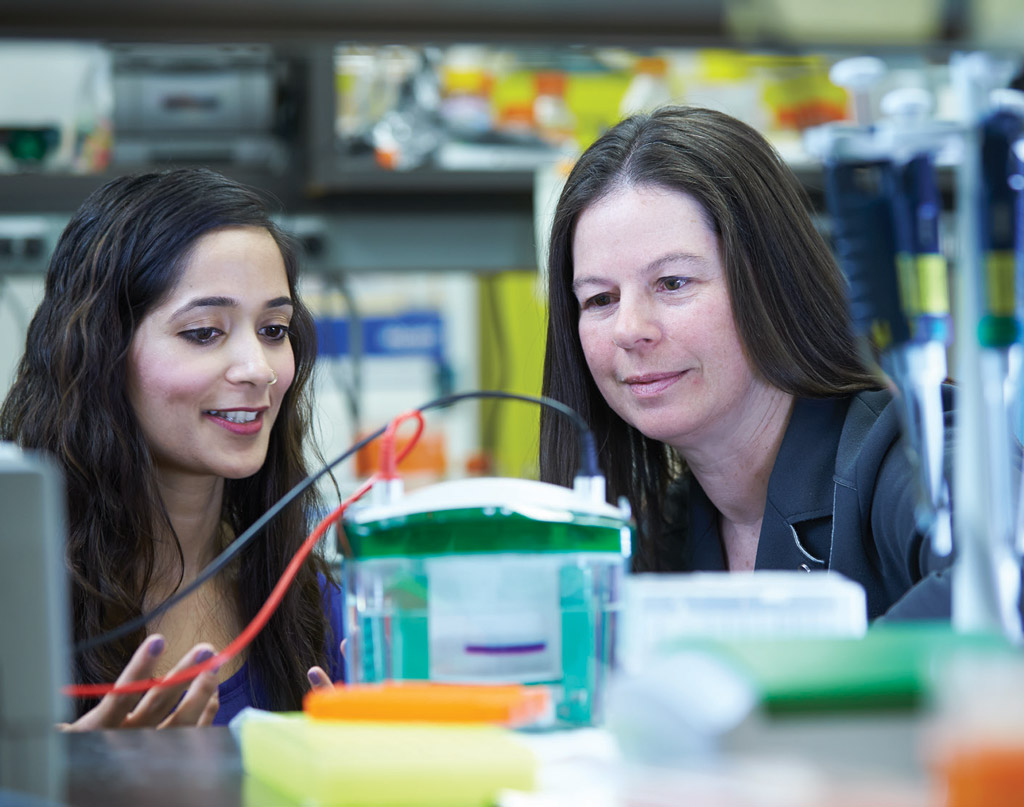
Dr. Isabelle Aubert (right) and PhD student Sonam Dubey. They are studying the use of focused ultrasound to deliver therapies directly to the brain to treat Alzheimer's disease.
That all of this is happening matters because, as Anderson notes, it’s particularly important for female trainees in science to observe women in positions of leadership. She points to the department of immunology at U of T where women make up 42% of its full professors, and the past interim chair and the head of graduate studies are women. “Both are at the top of their field,” says Anderson of her colleagues Drs. Dana Philpott and Jennifer Gommerman (whom she notes are also parents). “There are a lot of other women in the department who are very visible. It’s a good thing for young women to see.” The strong presence of senior female faculty at U of T’s department of immunology contrasts starkly with the “leaky pipeline” detected in immunology departments at American institutions. A 2016 study by Dr. Virginia Smith Shapiro and colleagues published in the Journal of Immunology shows that although women make up 50% of all U.S. graduate students and postdoctoral fellows in immunology, they are under-represented among immunology faculty members, accounting for 39.6% of assistant professors, 31.8% of associate professors and 22.3% of professors. It also showed that only three of the 25 responding departments or programs currently had a female chair.
Yet, helped by studies like these, awareness around diversity and equality is increasing; Anderson cites the list of female speakers compiled by the American Association of Immunologists that is promoted on its website as an example. “We want to show female trainees that they, too, can become PIs. If women sit in the audience [at conferences] and don’t see anyone like themselves up there at the podium, why should they think they are equipped to do that job if they don’t see anyone like them succeeding?” she says.
Women like Anderson, Chen and Aubert are role models for the next generation of female scientists. Sonam Dubey is a PhD student supervised by Aubert. Her research is on the use of focused ultrasound to open the blood brain barrier and deliver antibodies to the brain to treat Alzheimer’s disease. She will defend her thesis next year and plans to continue a career in research, potentially pursuing a postdoctoral fellowship. She says that throughout her studies she overcame difficulties and occasional self-doubt, but feels optimistic. “I feel like that imposter syndrome is going away slowly. I think I would make a good research scientist. I am hopeful in terms of getting somewhere, even with all of the funding issues and competition in academia. I’m lucky because I picked an area that is really growing in recognition and impact on health care,” she says.
Seeing Aubert flourish professionally while raising children and doing the things she loves is another source of optimism for Dubey. “Having that strong, supportive social circle is important, and having a family down the road is important to me. Doing something you love that helps you keep learning and growing would be, for me, having it all,” she says.
Like Dubey, Miho Tanaka, a PhD student in the lab of SRI senior scientist cell Dr. Jim Carlyle, also overcame a crisis of confidence during her doctoral research. Her thesis is on a type of immune called natural killer cells, which fight cancer and infection. She is studying how cancer alters the activation of natural killer cells and their ability to destroy cancer cells. She says that Carlyle’s support has helped her manage difficult moments during her studies. “He gives me space to deal with my issues when I have them. He is very understanding,” she says. Carlyle has also offered to connect her with a female scientist he knows, so that Tanaka can have a mentor with a different perspective.
The importance of mentoring was underscored by Dr. Mona Nemer, Canada’s Chief Science Advisor, in an address at the 2017 Gender Summit. Nemer recounted meeting an accomplished female biologist when she was a postdoctoral fellow. This scientist became a role model who showed that it was possible to have a thriving career while raising children. Nemer also said that 30 years after raising concerns about juggling work and family with this scientist, she encounters young female researchers contending with doubts about whether it is possible to have children and a successful scientific career. “Science and family are not mutually exclusive for men, why should they be for women?” said Nemer.
Dr. Claudine Hermann, who in 1992 became the first female professor appointed to École Polytechnique, a prestigious engineering school in France, said in a 2018 article in Science that her “greatest” challenge was juggling three sons and her career as a scientist. “Fortunately, my children were in good health, I had excellent help at home with a nanny, and my husband has always been very supportive.” Now vice-president of the European Platform of Women Scientists and president of honour of the Paris-based Femmes and Sciences Association, she noted, too, that she thinks it’s harder for this generation: “I believe that life as a woman scientist is more difficult nowadays than during my time. The many years of job instability that early-career researchers now typically go through and the increasing need for mobility can make private life difficult. My advice to women scientists is to be confident in your abilities, choose your partner well, and find good support in your network.”
Against this backdrop, when asked how she sees her prospects as a woman in science, Tanaka sighs. “That’s a difficult one. As a female PI, it’s really hard to take maternity leave, for example. You have to be there or else the lab will not move forward. That makes it hard to plan anything, even in the short term,” she says. Nonetheless, after defending her thesis in 2018, she plans to apply for postdoctoral fellowships and then look for a faculty position.
It is this drive that Chen and others underscore is essential to persevering. Her advice to any student, male or female? “I won’t take on a PhD student now unless you’re absolutely passionate or you have the potential and you want to continue in academia. There are too many people and no jobs. These students are talented, and there are other things they can do. Steve Jobs said that if you follow your passion, it’ll all work out. It might, but it might not; I think it’s harder now to do research than [it was for] the generation above me.”
For those who do persevere, there are insights to be had from those who have gone before them. What is Aubert’s secret to balancing her career and personal life? She says that while she generally integrates into her life the things she loves—family, science and athletics—she also has to prioritize duties. “Now it’s grant season, so I really need to buckle down and work on getting those grants written. There are times where having it all at the same time is not going to happen. So I’ll have all of my science for the next two months, and I’ll do more of the other things [later].”
System issues are being addressed, with positive change on the horizon and in some cases already happening, but these are largely outside any one person’s control and will take time. Not so solutions that focus on the day-to-day. Anderson’s advice when it comes to “having it all” is multifold, with a healthy dose of the pragmatic that echoes the counsel of other academics, male and female, who recommend getting help with caregiving and housework, which requires moving past stereotypes about gender roles. “You really should know what you’re up against and plan for it—have family around, have financial resources to hire people. That stuff should be in place and it will be much easier. Don’t expect to have to do it all yourself. Having it all doesn’t mean doing it all.”
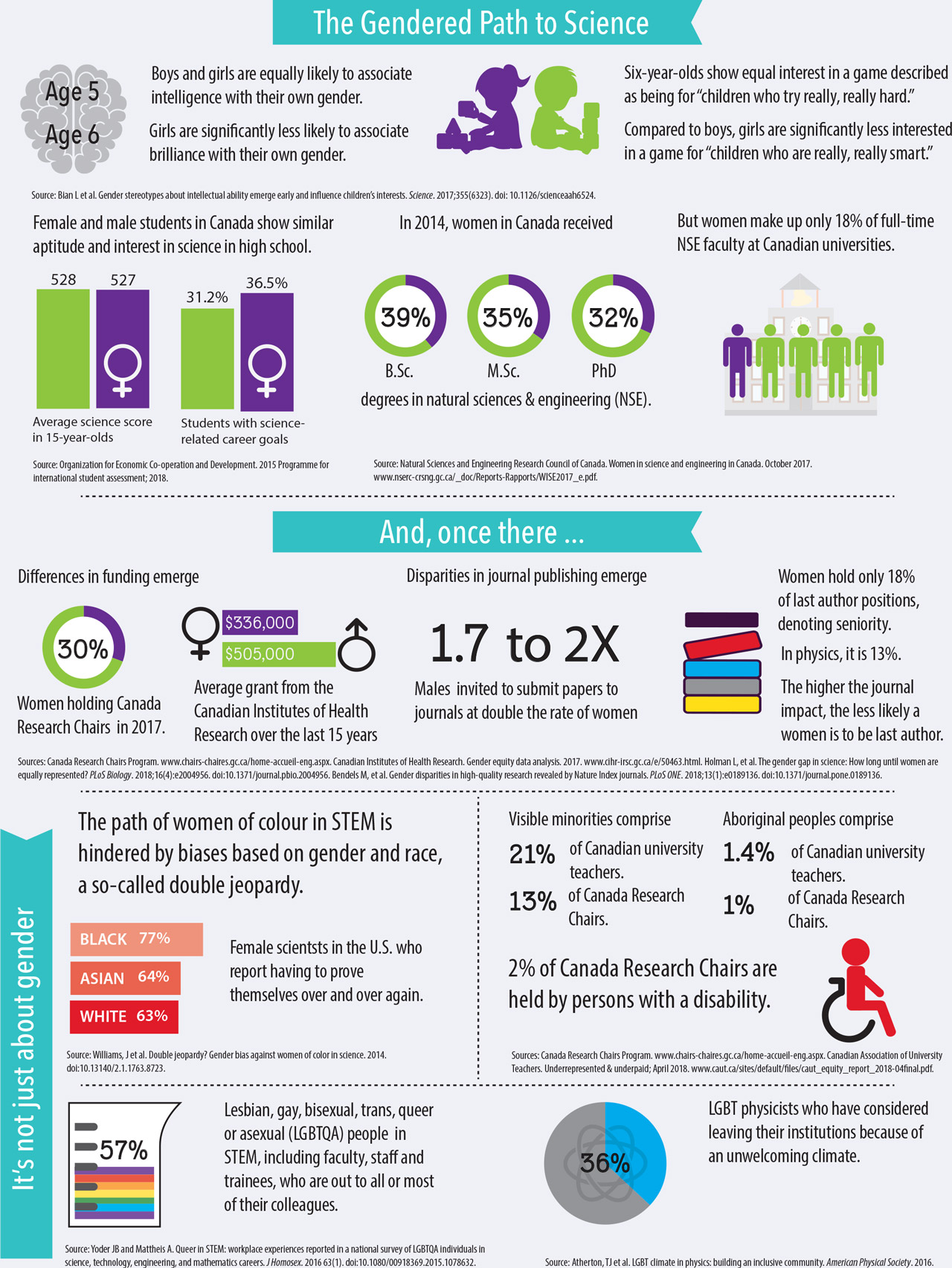
Read text-only version of above infographic
The Gendered Path to Science
Age 5: Boys and girls are equally likely to associate intelligence with their own gender.
Age 6: Girls are significantly less likely to associate brilliance with their own gender.
Six-year-olds show equal interest in a game described as being for “children who try really, really hard.”
Compared to boys, girls are significantly less interested in a game for “children who are really, really smart.”
Source: Bian L et al. Gender stereotypes about intellectual ability emerge early and influence children’s interests. Science. 2017;355(6323). doi: 10.1126/scienceaah6524.
Female and male students in Canada show similar aptitude and interest in science in high school.
Average science score in 15-year-olds: males: 528; females: 527
Students with science- related career goals: males: 31.2%; females: 36.5%
Source: Organization for Economic Co-operation and Development. 2015 Programme for international student assessment; 2018.
In 2014, women in Canada received 39% of B.Sc. degrees in natural sciences & engineering (NSE); 35% of M.Sc. degrees in NSE and 32% of PhD degrees in NSE. But women make up only 18% of full-time NSE faculty at Canadian universities.
Source: Natural Sciences and Engineering Research Council of Canada. Women in science and engineering in Canada. October 2017. www.nserc-crsng.gc.ca/_doc/Reports-Rapports/WISE2017_e.pdf.
And, once there …
Differences in funding emerge:
30%: women holding Canada Research Chairs in 2017.
Average grant from the Canadian Institutes of Health Research over the last 15 years: women: $336,000; men: $505,000.
Disparities in journal publishing emerge:
Males invited to submit papers to journals at double the rate of women.
Women hold only 18% of last author positions, denoting seniority. In physics, it is 13%. The higher the journal impact, the less likely a women is to be last author.
Sources: Canada Research Chairs Program. www.chairs-chaires.gc.ca/home-accueil-eng.aspx. Canadian Institutes of Health Research. Gender equity data analysis. 2017. www.cihr-irsc.gc.ca/e/50463.html. Holman L, et al. The gender gap in science: How long until women are equally represented? PLoS Biology. 2018;16(4):e2004956. doi:10.1371/journal.pbio.2004956. Bendels M, et al. Gender disparities in high-quality research revealed by Nature Index journals. PLoS ONE. 2018;13(1):e0189136. doi:10.1371/journal.pone.0189136.
It’s not just about gender
The path of women of colour in STEM is hindered by biases based on gender and race, a so-called double jeopardy.
Female scientsts in the U.S. who report having to prove themselves over and over again:
Black: 77%
Asian: 64%
White: 63%
Source: Williams, J et al. Double jeopardy? Gender bias against women of color in science. 2014. doi:10.13140/2.1.1763.8723.
Visible minorities comprise 21% of Canadian university teachers and 13% of Canada Research Chairs.
Aboriginal peoples comprise 1.4% of Canadian university teachers and 1% of Canada Research Chairs.
2% of Canada Research Chairs are held by persons with a disability.
Sources: Canada Research Chairs Program. www.chairs-chaires.gc.ca/home-accueil-eng.aspx. Canadian Association of University Teachers. Underrepresented & underpaid; April 2018. www.caut.ca/sites/default/files/caut_equity_report_2018-04final.pdf.
57%: Lesbian, gay, bisexual, trans, queer or asexual (LGBTQA) people in STEM, including faculty, staff and trainees, who are out to all or most of their colleagues.
Source: Yoder JB and Mattheis A. Queer in STEM: workplace experiences reported in a national survey of LGBTQA individuals in science, technology, engineering, and mathematics careers. J Homosex. 2016 63(1). doi:10.1080/00918369.2015.1078632.
36%: LGBT physicists who have considered leaving their institutions because of an unwelcoming climate.
Source: Atherton, TJ et al. LGBT climate in physics: building an inclusive community. American Physical Society. 2016.
Research Funding
Anderson: Canadian Institutes of Health Research (CIHR) and U of T. Aubert: CIHR, Natural Sciences and Engineering Research Council (NSERC) and the Weston Brain Institute. Chen: Canadian Partnership for Stroke Recovery, Heart and Stroke Foundation of Canada and NSERC.
Works Cited
Aldercotte A, Guyan K, Lawson J, Neave S, Altorjai S. Athena survey of science, engineering and technology 2016: experiences surrounding gender equality in STEMM academia and the intersections with ethnicity, sexual orientation, disability and age. 2017 Nov 20 [cited 2018 June]. In: Equity Challenge Unit. [Internet].
Bothwell E. Work-life balance survey 2018: long hours take their toll on academics. 2018 Feb 8 [cited June 2018]. In: Times Higher Education. [Internet].
Buffington C, Cerf B, Jones C, Weinberg BA. STEM training and early career outcomes of female and male graduate students: evidence from UMETRICS data linked to the 2010 census. Am Econ Rev. 2016 May;106 (5):333–38.
Callier V. Canadian science community gathers momentum in improving gender equity. 2018 Jan 18 [cited June 2018]. In: The Scientist. [Internet].
Casadevall A, Handelsman, J. The presence of female conveners correlates with a higher proportion of female speakers at scientific symposia. MBio. 2014 Jan 7;5(1):e00846-13.
Council of Canadian Academies, Expert Panel on Women in University Research. Strengthening Canada’s research capacity: the gender dimension. 2012.
Dowdeswell E, Fortier S, Samarasekera I. Report to the Minister of Industry of the ad hoc panel on Canada Excellence Research Chairs gender issues. 2010 Apr 23 [cited June 2018]. Innovation, Science and Economic Development Canada. [Internet].
Ecklund EH, Lincoln AE. Scientists want more children. PLOS ONE. 2011 Aug 5;6(8): e22590.
Eisenkraft H. Examining the roots of the perennial gender gap in the STEM disciplines. 2013 Oct 9 [cited June 2018]. In: University Affairs. [Internet].
Fletcher R. Women spend 50% more time doing unpaid work than men: Statistics Canada. 2017 June 1 [cited June 2018]. In: CBC News. [Internet].
Holman L, Stuart-Fox D, Hauser C. The gender gap in science: how long until women are equally represented? PLoS Biol. 2018 Apr;16(4):e2004956.
Moss-Racusin CA, Dovidio JF, Brescoll VL, Graham MJ, Handelsman J. Science faculty’s subtle gender biases favor male students. PNAS. 2012 Oct 9;109(41):16474–79.
Nemer M. Promoting diversity in STEM [speech]. Gender Summit. 2017 Nov 7.
Nittrouer CL, Hebl MR, Ashburn-Nardo L, Trump-Steele RCE, Lane DM, Valian V. Gender disparities in colloquium speakers at top universities. PNAS. 2018 Jan 2;115(1):104–8.
Shapiro VS, Kovats S, Parent MA, Gaffen SL, Hedrick CC, Jain P, et al. Update on gender equity in immunology, 2001 to 2016. J Immunol. 2016 Nov 15;197(10): 3751–53.
University of Toronto Office of the Vice-Provost, Faculty and Academic Life. Gender equity and pathways to leadership: women in the tenure stream at the University of Toronto (2004–05 and 2014–15). 2016.
Yong E. When will the gender gap in science disappear? 19 Apr 2018 [cited June 2018]. In: The Atlantic. [Internet].
Zhou CD, Head MG, Marshall DC, Gilbert BJ, El-Harasis MA, Raine R, et al. A systematic analysis of U.K. cancer research funding by gender of primary investigator. BMJ Open. 2018 Apr 30;8(4):e018625.
Celebrating women in science. 2018 Feb 9. In: Science. [Internet].
Gender equity data analysis: inequities in the larger health research landscape. [Internet]. Canadian Institutes of Health Research. [Modified 24 March, 2017; cited June 2018].
Gender equity data analysis: amount and duration of CIHR funding by gender (an overview). [Internet]. Canadian Institutes of Health Research. [Modified 15 Aug 2017; cited June 2018].

